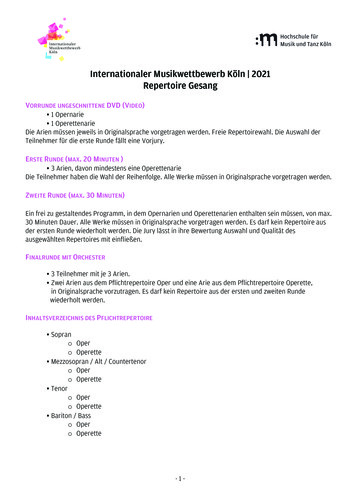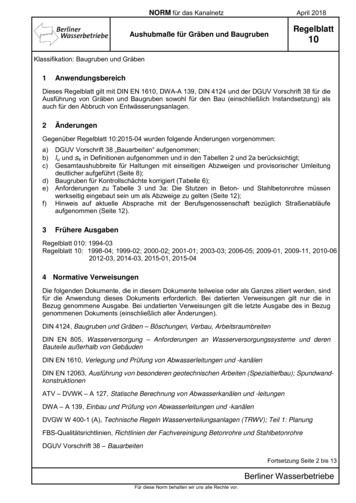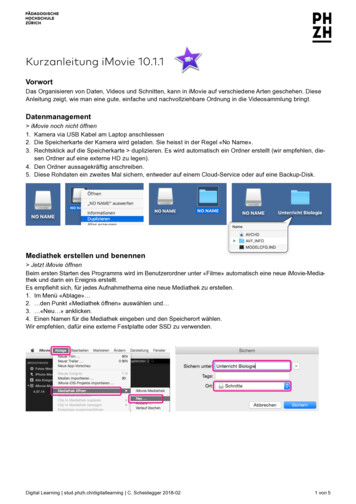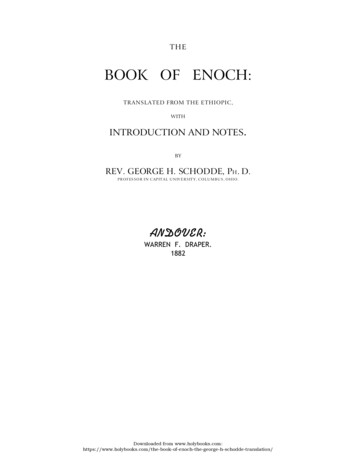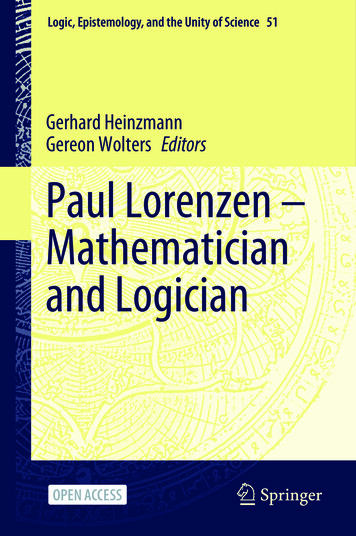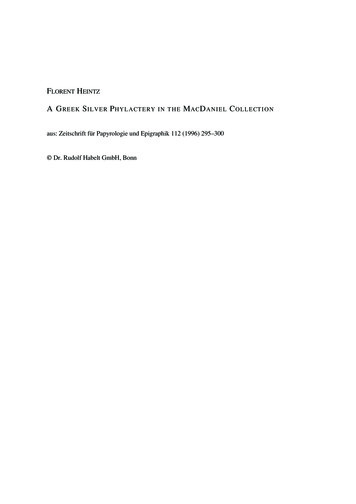
Transcription
FLORENT HEINTZA G RE E K S I L VE R P HYL ACT E RYI N T HEM AC D ANI E L C OL L E CT I ONaus: Zeitschrift für Papyrologie und Epigraphik 112 (1996) 295–300 Dr. Rudolf Habelt GmbH, Bonn
295A G R EEK S ILVER P HYLAC TER YIN THEM AC D ANIEL C OLLEC TION 1In 1992, a magical phylactery was purchased for the Classics Department's MacDaniel collection atHarvard.2 This long and narrow silver tablet, accompanied by a small fragment of its bronze case, is perfectly preserved except for the usual creases and ridges due to folding. Close scrutiny of the tablet revealshow it was manufactured. It was originally incised on a larger sheet of metal which was then flipped overand vertically cut with a sharp instrument. The slightly curved edges of the newly cut lamella would thencause it to cave in on the inscribed side and thus facilitate the roll-up process. It is quite likely that ourtablet was mass-produced as part of a whole set of lamellae which were first inscribed side by side on thesame silver sheet, then cut and individually packaged.The rather lengthy Greek inscription engraved on the lamella contains no magical characters. It runson 60 lines and is divided into two main sections: a series of Zauberworte, divine names and vowel combinations which takes up almost two thirds of the text (line 1-36), followed by a prayer for protectionagainst spells, ghosts and other misfortunes on behalf of Thomas, son of Maxima (line 37-60). In the firstpart, the engraver was careful not to split the sacred names, hence an average of 8 characters per line. Inthe second part, where words could be split at random, the average increases to about 11 characters perline. From the middle of the text onward, the quality of incising decreases consistently, becoming morecramped and shallow.Although the exact provenance of the lamella is unknown, one can use two pieces of external evidence to locate its origin in the Levant. On the one hand, before being sold to Harvard, the phylactery wasbought from a dealer who usually operates in and around modern Syria. On the other hand, it closely resembles in terms of width, script and general purpose another silver plaque from Beirut (dated to the IVthc. CE or later).3Although highly formulaic on the whole, the inscription on the MacDaniel phylactery contains severalfeatures that set it apart from other lamellae. First of all, not only is the prayer specifically meant as a protective device against enchantments by means of curse tablets (the katay !imoi of lines 45-46), but inseveral instances it seems to be replicating deliberately their language (esp. 9,30-33, 46-48, 52-53, 5660). Secondly, the introductory sequence of ÙnÒmata (1-36) is definitely not one that would normally beexpected from a talisman. It contains several elements typical of aggressive, chthonic, magic and stands as1 Special abbreviations:DTGMADefixionum Tabellae, ed. A. Audollent (Paris 1904).Greek Magical Amulets: The Inscribed Gold, Silver, Copper and Bronze Lamellae, Part 1: Published Texts ofKnown Provenance, ed. R. Kotansky, Papyrologica Coloniensia 23/1 (Opladen 1994).PGMPapyri Graecae Magicae. Die griechischen Zauberpapyri, 2 vols., ed. K. Preisendanz, 2nd. ed. A. Henrichs (Stuttgart 1973-1974).SGDD. Jordan, "A survey of the Greek Defixiones not Included in the Special Corpora", GRBS 26 (1985) 151-197.Suppl. Mag. Supplementum Magicum, 2 vols., eds. R.W. Daniel-F. Maltomini, Papyrologica Coloniensia 16.1 and 2(Opladen 1990 and 1991).I am grateful to D.G. Mitten for entrusting me with the publication of the piece. My appreciative thanks are also due toC.A. Faraone, A. Henrichs, C.P. Jones, L. Koenen and R.D. Kotansky for their support and guidance. Lastly, I should liketo express my recognition of the fine conservation work done by H. Lee and his staff at the Fogg Museum of Art.2 It is presently stored in the Ancient Art Collection, Arthur M. Sackler Museum, Cambridge, Mass., under the temporary access number TL 33416.3 Cf. GMA 52 and D.R. Jordan, "A New Reading of a Phylactery from Beirut", ZPE 88 (1991) 61-69, plate II. It is aswide as our piece (3 cm on average) but longer (37.5 cm). Its script is strikingly similar to the MacDaniel's one although theletters are smaller with a higher average of characters per line. Worth noting among other resemblances between the Alexandra and MacDaniel phylacteries are: the way e and l merge when written consecutively (cf. GMA 52, 4-5: Elavy; McD., line57: m lo!); the same three epithets applied in the same order to the divine names (cf. GMA 52,109-110; McD., line 37-39);similar concerns towards warding off ghosts and curses alike (cf. GMA 52, 12-13, 75-76, 90-91; McD., lines 43-48).
296F.Heintzthe longest parallel known so far, in a metal amulet, to the magical papyri. It appears within a GrecoEgyptian love-charm dated to the IVth-Vth c. CE. I have reproduced this section below side by side withthe phylactery's transcription.4MacDaniel PhylacteryPl. IV.114812162024283236TextYvyv iyi iyiMoumvyuriZvouk zaoukxyv Iav taEntofrhTayiXouxe xouxeXvj abavy Iav ouia Ivou IavouyAi ai aiIou iou iou,ëgia ka ‹ fi!xuråka‹ dunatå ÙnÒmata tå t ! me-2.8 cm. x 25.3 cm.; thickness: .0162 cm.;weight: 6.64 gmsvIV-V CEPGM XIXa, 6-9 (for comparison)6Yvyvyv iyi iyi u]n Blamouniy Bivy mvAr!enofrhBirbhkafiv,Iav hiaiahHihi au[an]Xouxe xouxeXvj UpoxyvnIvouy IavouyAi ai aiOu ou ou4 For love charms on laed tablets as applications of PMS IV see D.G. Martinez, A Greek Love Charm from Egypt (P.Mich. 757), P. Mich XVI, Am. Stud. in Pap. 30 (Atlanta 1991), esp. 6-8.
A Greek Silver Phylactery in the MacDaniel Collection404448525660297gãlh! ÉAnãgkh!,diatirÆ!ate ka‹diafulãjateépÚ pã!h! goet a! ka‹ farmak a! ka‹ kataye! mvn ka‹ é rvn ka‹ bei vn ka‹ pantÚ! kakoË prãgmato! to !oma ka‹ tØ n cuxØnka‹ pçn m lo!toË ! mato!Yvmç, n ¶teken Mãjima,épÚ t ! !Æmeron m ra!ka‹ efi! tÚn j ! ëpantaxrÒnon aÈtoË.41 read diathrÆ!ate43/44 read gohte a!read bia vn50 read !«ma44/45 read farmake a!45/46 read katad !mvn47/48"(magical words) holy, mighty and powerful names of the great Necessity, preserve and protect fromall witchcraft and sorcery, from curse tablets, from those who died an untimely death, from those whodied violently and from every evil thing, the body, the soul and every limb of the body of Thomas, whomMaxima bore, from this day forth through his entire time to come."1-36: This entire sequence is a self-contained logos meant as an invocation to the deity called ÉAnãgkh in line 40. It occurs elsewhere with the usual variations inserted among other formulas in line 6b-9 of PGM XIXa (cf. supra), a love-charmwritten on a single sheet of papyrus (30 x 22.8 cm) found in Hermopolis, modern Eschmunên, in Egypt (the inscription itself reveals that it was placed in the mouth of a mummy in order to use the dead person's soul [nekuda mvn, line 15] as aspell-carrier). Both the phylactery's and the papyrus' versions of the logos are based on an earlier Vorlage which it is sometimes possible to reconstruct (cf. comms. to line 19). Among its most notable features, the logos contains several names ofEgyptian deities (lines 1: Thoth; 13: Horus; 14: Arsnuphis; 24: Ra [?]) together with their Egyptian epithets. The chthonic,infernal nature of the invocation is undeniable (cf. lines 1, 4, 9, 12, 30-33) and quite unusual in an apotropaic context.All in all, the Yvyv-logos seems to be made of 36 ÙnÒmata. The scribe emphasized the cuts by starting on the nextline after each magical word and, in the process, managed to break only two of the names (lines 32/33 and 33/34 respectively). The number of ÙnÒmata might refer to the 36 decans of the Zodiac like the 36 charaktêres which were engraved at thetop of a late Antique Syrian curse tablet and then invoked at the beginning of the prayer as kÊrioi ègi tatoi xarakt re! (cf.W. Van Rengen, "Deux défixions contre les Bleus à Apamée," Apamée de Syrie [Brussels 1984] 215-219; lists of decans inW. Gundel, Dekane und Dekansternbilder [Glückstadt/ Hamburg 1936] 76-81). There is indirect evidence for the use of decansin phylacteries. A VIth c. BCE Phoenician gold phylactery from Tyre has 36 egyptianizing figures which are likely to standfor the decans (cf. H. Lozachmeur - M. Pezin, “De Tyr: Un nouvel étui et son amulette magique à inscription,” Etudesisiaques: Hommages à J. Leclant IFAO 106/3 [Cairo 1993] 362 and n.8). From the late Imperial period, a Syrian curse tablet(DT 15) aimed at a pantomime tries to cancel the assistance which the d kanoi (line 8) could provide to the target.Ancient medical astrology assigned each part of the human body to the tutelage of a particular decan (cf. Origen ContraCelsus 8.58; W. Gundel, Dekane 262ff.). It is, therefore, certainly significant that, in our phylactery, 36 secret names are being invoked to protect "every limb (pçn m lo!) of the body of Thomas" (line 52-53 and comments). Whenever a curse tabletclaims to name all the parts to be damaged in the target's body, it usually enumerates 36 of them (cf. J.G. Gager, CurseTablets and Binding Spells from the Ancient World [New York/Oxford 1992] 240-242, #134). In addition, one of the namesin the logos (Pi!andrapth!, line 29) features prominently in a Coptic gnostic-magical tractate as one of the personified beings responsible for activating parts of the human body (cf. infra). The astrological character of the yvyv-logos is further
298F.HeintzTablets and Binding Spells from the Ancient World [New York/Oxford 1992] 240-242, #134). In addition, one of the namesin the logos (Pi!andrapth!, line 29) features prominently in a Coptic gnostic-magical tractate as one of the personified beings responsible for activating parts of the human body (cf. infra). The astrological character of the yvyv-logos is furtherconfirmed by the deity it is meant to invoke, i.e. Ananke, master of destiny, ruling over planets, stars and gods alike (cf. W.Gundel, Weltbild und Astrologie in den griechischen Zauberpapyri [Munich 1968] 70-72; see our comments to lines 39-40).1 Yvyv iyi iyi: Yvyv (cf. PGM XIII.810 and, within the axaifv- palindrom, I.326, IV.463. 1986, etc.) is Egyptian for"Thoth the Great," the deity of the underworld a.k.a. Hermes Trismegistos. In a Greek inscription from Tunah-el-Gebel, ThotTrismegistos appears as Y«uy VVV (corresponding to dh wty Ñ'w [ ]); hence single v may indicate m ga! (so Koenen withreference to V. Guirgis, Mitt. d. Deutschen Arch. Institues, Kairo, 20 [1965] 121). As for iyi iyi, it has the same meaningwhether it is read as an Egyptian invocation formula ("let him come" [twice]) or as the repetition of the Greek 2nd pers. sing.imp. of e‰mi: ‡yi ‡yi ("come, come," cf. Sophocles, Philoctetes 832).4 Xyv xyvn: The name Xyvn, without the reduplication, can be found in another logos which, not surprisingly, ismeant to invoke chthonic deities (xyÒnioi yeo ) in several curse tablets from Cyprus (DT 22.14; 24.6; 26.10, etc.). Preisendanz's index to his edition of the magical papyri mentions a Xyvn only in PGM XXIII.5. The corresponding Xyeyvni inPGM XIXa.7 seems to be more frequent (cf. PGM V.485; VII.368; XIII.906; DT 252.4; 253.5).9 Forbarbarvr: A vox magica from the Borphor-series (e.g. PGM IV.2347-2352) which is frequently used to invokethe patron deities of all magicians, Hekate and Typhon, and appears almost exclusively in curse tablets, not in protectivelamellae (cf. D.R. Jordan, "Defixiones from a Well near the Southwest Corner of the Athenian Agora," Hesperia 54 [1985]240-241).11 Bolxo!hl: The corresponding line in the Hermopolis papyrus has preserved the standard Bolxo!Æy (cf. PGMIV.2025, XII.372, etc.). With the phylactery's ending in lambda, however, the word seems to fall into the category of angelicnames in -hl; cf. A.M. Kropp, Koptische Zaubertexte I-III (Brussels 1931) xiii.3 Balba l (demotic Bøbø l, see II p. 35 andindex; also xlvii. 18.17 Bøbø l). One can also read it as a composite Semitic divine name made of three elements: BWL (bøl BaÑal, “the Lord”; for names starting in BWL-, cf. J.K. Stark, Personal Names in Palmyrene Inscriptions [Oxford 1971] 8,74), QWS (i.e.Qøs, the name of the principal Edomite god) and the ending -EL (for “god”). Originally, the entire name couldhave meant: “the Lord P is god”. At least the two first elements of the name occur on a fragmentary Edomite ostrakon(“.BLKWSHP.,” in I. Beit Arieh, “The Edomite Shrine at Horvat Qitmit in the Judean Negev. Preliminary ExcavationReport,” Tel-Aviv 18 [1991] 93-116, fig. 17).12 Eri!xigal: The Hermopolis papyrus has once more the standard spelling [Er]e!xigãl (cf. PGM IV.2484; VII. 317).Ereshkigal is the Babylonian goddess of the underworld oftentimes identified with Persephone (cf. PGM IV.337) or Hekate(cf. PGM LXX.4-5).13 Ar!amv!i: Cf. PGM II.155; XI.91-92; XIII.626, etc. Possibly Egyptian for "Horus the first-born" when read with arough breathing (cf. The Greek Magical Papyri in Translation, ed. H.D. Betz [Chicago 1992] 335).14 Ar!enofrh: Cf. PGM II.217, IV.1629, XII.183; Suppl. Mag. 42.56; 49.44. The Egyptian god Arsnuphis, associatedwith Nubia and consort of the goddess Tefnut (cf. W. Spiegelberg, s.v. "Arsnuphis," Reallexikon der Ägyptischen Religionsgeschichte, H. Bonnet, ed. [Berlin/New York 1971] 55-56). See Kotansky’s comments to GMA 36.4 (p. 186) for furtheranalysis of the name.16 Iav hahoh: See also line 33. Iav is probably derived from the name of the Jewish god, the tetragrammaton YHWH(latest discussion in D.G. Martinez, [above n. 3] 79f.). For formations of Iav vowel strings, cf. GMA 4.7 (Iav ehouiaeu;PGM XII.189 (Iav ouehvhv etc.); XIII.887 (Iav hiiuueehhoa, etc.). For Iav as protection from the evil eye see J.Engemann, "Magische Übelabwehr in der Antike", Jb. Ant. u. Christ. 18 (1975) 37.17 Hihi: Similar vowel sequence in PGM II.154; VII.307; XIII.943, 993; cf. Suppl. Mag. I 48 (P. Mich. XVI. 757[above, n. 3]) G 16, 18, 21.19 Araiavy: The closest parallel to this name in the papyri is Arbaiavy (i.e. the third element of theÑVro!-logos; e.g.PGM IV.1077) which itself derives by letter permutation from the more common Arbayiav (cf. PGM IV.1564, V.479.981,XXXVI.308, etc.; W. Fauth, "Arbath Jao," Oriens Christianus 67 [1963] 64-75). It is likely that Arbaiavy was present inthe original version of the Yvyv-logos since the corresponding Arbivy in the Hermopolis papyrus (PGM XIXa.8) hasretained the beta in yet another variant of the name.29 Pi!andrapth!: Pisandraptês is one of the 360 daemons (10 per decan) responsible for activating all parts of the human body in the Apocryphon of John (65.16-17; cf. Apocryphon Johannis, ed. S. Giversen [Acta Theologica Danica 5;Copenhagen 1963]). R. Kotansky pointed out to me that he knows of an unpublished silver phylactery where the name occurs three times.30-33 Oreobarzagra, Ma!kelli, Fnoukentabavy: A sub-sequence within the larger incantation. It derives fromthe well-known Maskelli formula (in its full, standard, form: Ma!kelli, Ma!kello, Fnoukentabavy, Oreobazagra,Rhjixyvn, Ippoxyvn, Puriphganuj) which was specifically meant to invoke Ananke (cf. K. Preisendanz, s.v. "Maskelli,"RE14 [1928] 2120; also Suppl. Mag. I.12.3f. note and below 37-39). This chthonic formula, typical of defixiones and aggressive magic in general, is quite unusual in an apotropaic context and shows how the author of the phylactery tends tochoose his weapons from the same arsenal as his (potential) opponents.33 Iav ouia: Cf. line 16.35 Ai ai ai: Same sequence of vowels in PGM IV.1791 (see also R. Wünsch, Antikes Zaubergerät aus Pergamon [Berlin1905] 13, lines 56-7).
A Greek Silver Phylactery in the MacDaniel Collection299ka‹ dunatå ÙnÒmata. See also, among many other instances, GMA 58.12; PGM IV.1192 (tÚ ˆnoma tÚ ëgion ka‹ tÚfi!xurÒn), and a Latin curse tablet (DT 250.27-29: et te ad[iu]ro quisque inferne [es] per hec sancta nomina Necessitatis). Fordirect invocations of the Ùnãmata see Suppl. Mag. I. 45.52f. (after katå t ! krateç! ÉAnãgkh! and Maskelli-logos in34): tå ëgia ÙnÒmata taËta ka‹ dunãmi! a tai §pi!{!}xurÆ!ate ka‹ tel›te tØn §paudÆn. For other examplessee Daniel's and Maltomini's note ad loc.39-40 t ! megãlh! ÉAnãgkh!: Necessity, who plays an important role in the Orphic theogonies, is invoked here as thesupreme deity ruling over all other divine or demonic powers (cf. Plato Laws VII 818e; K. Wernicke, s.v. "Ananke" RE 1[1894] 2057-8; H. Schreckenberg, ANANKE: Geschichte des Wortgebrauchs [Munich 1964] 135-164). In the Hermopolislove-spell (lines 13-14), the prayer starts with an invocation to a mysterious "guardian of the strong destiny (melhtØ! t !kraterç! ÉAnãgkh!), who manages my affairs, the thoughts of my soul, which no one can speak out against, not a god,not an angel, not a daimon" (transl. E.N. O'Neil and R. Kotansky, The Greek Magical Papyri in Translation, ed. H.D. Betz[Chicago 1992] 256). For more references to Ananke in the papyri, cf. Suppl. Mag.12.2 and 45.1.31 (quoted to lines 37-39).41 diatirÆ!ate: Rare in prayers on amulets. Eugenia's phylactery(cf. C. Faraone - R. Kotansky, "An Inscribed GoldPhylactery in Stamford, Connecticut," ZPE 75 [1988] 257-266) has terã!ate (line 15) and a North African amulet againsthail-storm uses !unthrÆ!ate (cf. GMA 11b.13). The verb diathr v does not even appear in recipes for phylacteries preserved in the papyri (elsewhere in PGM, cf. III.607, IV.2980, V.44, VII.453).42 diafulãjate: The idea is the same as in diatirÆ!ate but conveyed through a much more common verb in the vocabulary of protective magic. The 2nd pers. imp. aor. act. of diafulã!!v, either singular or plural, occurs in countless metalamulets. See for instance the following phylacteries: Alexandra, lines 6, 73, 110-111 (GMA 52); Aurelia, lines 17-18, 22and vertical margin (cf. R. Kotansky, "Two Amulets in the Getty Museum," The J. Paul Getty Museum Journal 8 [1980]181); John and Georgia, lines 18-19 (GMA 41); Eugenia, line 27 (ref. supra); Mastarion, lines 4-5 (cf. M.C. Ross, Catalogue of the Byzantine and Early Medieval Antiquities in the Dumbarton Oaks Collection, vol. 2, Jewelry, Enamels and Artsof the Migration Period [Washington, D.C. 1965] no. 28); Syntyche, lines 8, 11, 14, 16-17 (cf. W. Froehner, in Bulletin dela Société des Antiquaires de Normandie 4 [1866-67] 222). On gemstones, cf. A. Delatte - Ph. Derchain, Les intailles magiques gréco-égyptiennes de la Bibliothèque Nationale (Paris 1964) # 23, 28, 80, etc. In the papyri, cf. PGM IV.924.1079.2516; VII.497, etc.43-45 goet a! ka‹ farmak a!: Such a combination of general terms, in addition to the katay !imoi of lines 45-46,is quite unique among phylacteries aimed at warding off attacks of witchcraft. Thus, farmak a alone is used in only twometal phylacteries, those of Syntyche (lines 8-9; ref. supra) and Juliana (GMA 46.11-12). Most countercharms name onlyspecific magical operations: Alexandra (GMA 52.12-13) wants to be preserved "from spells/poisons and curses (farmãkvnka‹ katãde!mvn; see also lines 75-76, 90-91); a phylactery whose invention was attributed to Moses (GMA 32) insuresthat the bearer will fear "neither the magician (mãgon) nor the curse (katad !mon)" (lines 10-11; see also lines 25-27, 3224). For the oldest Greek counterspell on a lamella, see Inscriptiones Creticae 2.19, lines 13, 17 and 20). Recipes forlu!ifãrmaka (counterspells) to be inscribed on lamellae, potsherds or papyrus strips can be found in several formularies (cf.refs. in GMA p. 191).45-46 kataye! mvn: Most likely a misspelling of katad !mvn (in phylacteries, cf. above GMA 32.11; 52.13). Asan alternative, one could also try to salvage the word, which is unattested in Greek, by reading it as a combination of kataand -ye!imo! (elsewhere only after épo-, §k-, para- and peri-; cf. P. Chantraine, Dictionnaire étymologique de la languegrecque, vol. IV/1 [Paris 1977] 1117). As an adjectival form close to the substantive katãye!i!, its meaning could ultimately derive from katat yhmi, "to lay down," "to deposit," which is used in the context of cursing together with katagrãfv or katad v in order to "hand over" someone to the gods for punishment or constraint (cf. DT 74; 75; SGD 21;H.S. Versnel, "Beyond Cursing: The Appeal to Justice in Judicial Prayers," Magika Hiera [Oxford 1991] 66, 77, 80). Furthermore, katat yhmi also means "to bury" (cf. Mk 15:46; cf. tÚ katad !ion, "sepulchre, container of relics; Lampe s.v.)and is used in the papyri (cf. PGM V.345; VII.455; XXXVI.3) when describing the way curse tablets are to be "laid downunderneath" the earth (in burials, circus arenas, etc.) or bodies of water (in rivers, wells, etc.). A recipe for a spell written onpapyrus requires: "deposit it with one who has died a violent death" (PGM XIXb, 5: katat you efi! bioyãnaton). Hence,the katay !imoi may have concrete overtones in addition to their primarily abstract meaning. They would still refer to cursetablets, although indirectly through an euphemism: "things deposited" or "laid down" both in a literal and figurative, judicial,sense.46-48 é rvn ka‹ bei vn: The spirits of the dead, and especially of those who had met with an untimely or/and violent demise, were believed to haunt their place of burial (cf. J.H. Waszink, s.v. "Biothanati," RAC, vol.2 [1954] 391-4). Themagician thought he could manipulate those restless spirits at will by "binding" them with the help of more potent supernatural entities (gods, angels, etc.; cf. PGM IV.1400-1). The most common medium to secure the ghosts' cooperation was toengrave "powerful names" and the details of the spell on a lead tablet. The MacDaniel lamella is unique among metal amuletsin using words as specific as êvro! and b aio!, otherwise extremely frequent in the papyri (e.g. PGM IV.333-334) and incurse tablets (cf. index to DT, p. 465-470; Van Rengen, "Deux défixions.," p. 215, line 7-8: d mona! é rou!, d mona!bi ou!; cf. Th. Hopfner, Griechisch-Ägyptischer Offenbarungszauber [Leipzig 1921; in typescript edition, Amsterdam 1974]vol. 1, parag. 351-352 and D.G. Martinez [above, n. 3], note to line J4). In phylacteries, the spellbound spirit of the dead isusually implied in such terms or phrases as pneËma ponhrÒn (GMA 32.11) or daimÒnion even when spells and curse tabletsare mentioned along with it (GMA 52.8-13).
300F.Heintz48-50 (épÚ) pantÚ! kakoË prãgmato!: This stock formula, usually introduced by an imperative form of (dia)fulã!!v (cf. line 42) appears on many kinds of amulets. Our lamella resorts to the longer version of it (cf. PGM LXXI).There were medium-size (épÚ pantÚ! kakoË: cf. S. Eitrem, "A New Christian Amulet," Aegyptus 3 [1922] 66, line 2f.)and shorter versions as well, the latter being particularly suited for small gemstones (épÚ kakoË: cf. C. Bonner, Studies inMagical Amulets, Chiefly Graeco-Egyptian [Ann Arbor, Mich. 1950] 46, #6).50-51 (diafulãjate) tÚ !Òma ka‹ tØ n cuxØn: Compare with a recipe for a metal phylactery in PGM XIII.589590: diafÊla!!e mou tÚ !«ma, tØn cuxØn ılÒklhron §moË). For !«ma only, see GMA 56.9 and a papyrus amulet buriedwith a mummy (PGM LIX.11: fulãjate tÚ !«ma toË Fye ou). For cuxÆ only, cf. GMA 41.20; 67.7. Both terms areextremely common in defixiones (see Audollent's index in DT, p. 487ff.; SGD 146; 147).52-53 ka‹ pçn m lo! toË ! mato!: The text is barely legible towards the end of line 52 but, if my reading is correct,the emphasis on "every limb" is worth noting as yet another example of how heavily our phylactery draws upon the language of curse tablets: the formula "I bind every limb (pçn m lo!) of NN" appears in two spells from Audollent's compilation (DT 241; 242).54-55 Yvmç, n ¶teken Mãjima: The Biblical name Thomas, of Aramaic origin, is typically Christian and is not attested anywhere outside Syria-Palestine before the advent of Christianity (cf. I. Kajanto, Onomastic studies in the EarlyChristian Inscriptions of Rome and Carthage [Helsinki 1963] 116). It occurs quite late in Egyptian papyri (from the Vth c.CE onwards; cf. D. Foraboschi, Onomasticon alterum papyrologicum [Milan 1967] 141, s.v. Y«ma!). As to the Latin female cognomen Maxima standing by itself, it also becomes popular only in the Christian period (for Latin inscriptions, cf.index to Diehl’s Inscriptiones Latinae Christianae Veteres, vol. 3, s.v. Maxima [numerous occurences from the end of theIVth c. CE onwards]; in Greek papyri, cf. F. Preisigke, Namenbuch [Heidelberg 1922] s.v. Mãjima, p. 205 [two examplesfrom the VIth c. CE]).56-60 épÚ t ! !Æmeron m ra! ka‹ efi! tÚn j ! ëpanta xrÒnon aÈtoË: The closest parallel appears in a consecration formula to be pronounced over a stone amulet (PGM IV.1692: épÚ t ! !Æmeron m ra! efi! tÚn ëpanta xrÒnon; cf.PGM I.165-166). Slightly longer is the version of a Syrian gold phylactery (GMA 57. 19-21: é]pÚ t ! !Æmer!on, [ m ra!]ka‹ épÚ t ! êrti [efi! tÚ]n pãnta xrÒnon, ktl). Not surprisingly, these temporal formulas were even more widely used incurse tablets: cf. DT 156.33,42; 159a.74; 160.116-117; 271.43; P. Moraux, Une défixion judiciaire au Musée d'Istanbul(Brussels 1960) 12, line 16-19; SGD 179.Harvard UniversityFlorent HeintzZPE 114 (1996) 96C ORRE CT I ONSIn F. Heintz, "A Greek Silver Phylaktery in the Mac Daniel Collection" (pp. 295-300) a serious printingerror occured:(1.) p. 298, lines 1-3 were repeated from the bottom of the preceding page.(2.) Correspondingly, 3 lines are missing at the bottom of p. 298. We print here F. Heintz' note toline 36 and his entire explanation to lines 37-39 the first two lines of which have dropped out:36 Iou Iou Iou: Cf. PGM LXXVII.14-15; Suppl. Mag. II.96.47.37-39: ëgia ka ‹ fi!xurå ka‹ dunatå ÙnÒmata refers back to all the magical names of lines 1-36. It is a stock invocation in prayers for protection. Alexandra's phylactery (GMA 52, lines 109-110) has the best parallel: ëgia ka‹ efi!xurå ka‹dunatå ÙnÒmata. See also, among many other instances, GMA 58.12; PGM IV.1192 (tÚ ˆnoma tÚ ëgion ka‹ tÚ fi!xurÒn),and a Latin curse tablet (DT 250.27-29: et te ad[iu]ro quisque inferne [es] per hec sancta nomina Necessitatis). For directinvocations of the Ùnãmata see Suppl. Mag. I. 45.52f. (after katå t ! krateç! ÉAnãgkh! and Maskelli-logos in 34): tå ëgiaÙnÒmata taËta ka‹ dunãmi! a tai §pi!{!}xurÆ!ate ka‹ tel›te tØn §paudÆn. For other examples see Daniel's andMaltomini's note ad loc.On p. 296 in the middle between the text columns of the MacDaniel Phylactery (line 4) and PGMXIXa, line 7, appears an omega which was not intended to be there.The author had no chance to detect the errors since they occured after he had read the proofs. Theeditors apologize to him as well to our readers.
TAFEL IVSilver lamella with Greek inscription from the Alice C. McDaniel Collection, Department of the Classics,Harvard University; left: ll. 1–38, right: ll. 39–60
Egyptian deities (lines 1: Thoth; 13: Horus; 14: Arsnuphis; 24: Ra [?]) together with their Egyptian epithets. The chthonic, infernal nature of the invocation is undeniable (cf. lines 1, 4, 9, 12, 30-33) and quite unusual in an apotropaic context. All in all, the Yvyv-logos seems to be made of 36 ÙnÒmata. The scribe emphasized the cuts by .
